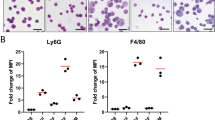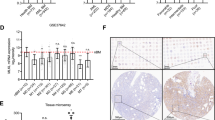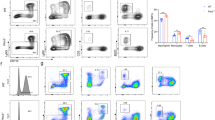Abstract
Macrophage colony-stimulating factor (M-CSF) has been found to be involved in multiple developmental processes, especially production of cells belonging to the mononuclear phagocyte system. The decision of myeloid progenitor cells to commit to differentiation depends on activation levels of the mitogen-activated protein kinases (MAPK), ERK1 and ERK2. Using the murine myeloid progenitor cell line FD-Fms, we show here that persistent activity of Src-family kinases (SFK) is necessary for FD-Fms cell differentiation to macrophages in response to M-CSF. Chemical inhibition of SFK blocked FD-Fms cell differentiation while it caused strong inhibition of the late phosphorylation of phospholipase C (PLC)-γ2 and MAPK. The PLC inhibitor U73122, previously shown to block M-CSF-induced differentiation, strongly decreased long-term MAPK phosphorylation. Interestingly, inhibiting SFK with SU6656 or the MAPK kinases MEK with U0126 significantly impaired development of mononuclear phagocytes in cultures of mouse bone marrow cells stimulated with M-CSF. Collectively, results support a model in which SFK are required for sustained PLC activity and MAPK activation above threshold required for commitment of myeloid progenitors to macrophage differentiation.
This is a preview of subscription content, access via your institution
Access options
Subscribe to this journal
Receive 12 print issues and online access
$259.00 per year
only $21.58 per issue
Buy this article
- Purchase on Springer Link
- Instant access to full article PDF
Prices may be subject to local taxes which are calculated during checkout







Similar content being viewed by others
References
Kahan C, Seuwen K, Meloche S, Pouyssegur J . Coordinate, biphasic activation of p44 mitogen-activated protein kinase and S6 kinase by growth factors in hamster fibroblasts. Evidence for thrombin-induced signals different from phosphoinositide turnover and adenylylcyclase inhibition. J Biol Chem 1992; 267: 13369–13375.
Qui MS, Green SH . PC12 cell neuronal differentiation is associated with prolonged p21ras activity and consequent prolonged ERK activity. Neuron 1992; 9: 705–717.
Sharp LL, Schwarz DA, Bott CM, Marshall CJ, Hedrick SM . The influence of the MAPK pathway on T cell lineage commitment. Immunity 1997; 7: 609–618.
Brummer T, Shaw PE, Reth M, Misawa Y . Inducible gene deletion reveals different roles for B-Raf and Raf-1 in B-cell antigen receptor signaling. EMBO J 2002; 21: 5611–5622.
Matsumura I, Nakajima K, Wakao H, Hattori S, Hashimoto K, Sugahara H et al. Involvement of prolonged ras activation in thrombopoietin-induced megakaryocytic differentiation in a human factor-dependent hematopoietic cell line. Mol Cell Biol 1998; 18: 4282–4290.
Garcia J, de Gunzburg J, Eychene A, Gisselbrecht S, Porteu F . Thrombopoietin-mediated sustained activation of extracellular signal-regulated kinase in UT7-Mpl cells requires both Ras-Raf-1- and Rap1-B-Raf-dependent pathways. Mol Cell Biol 2001; 21: 2659–2670.
Dorrell C, Takenada K, Minden MD, Hawley RG, Dick JE . Hematopoietic cell fate and the initiation of leukemic properties in primitive primary human cells are influenced by Ras activity and farnesyltransferase inhibition. Mol Cell Biol 2004; 24: 6993–7002.
Gobert-Gosse S, Bourgin C, Liu WQ, Garbay C, Mouchiroud G . M-CSF stimulated differentiation requires persistent MEK activity and MAPK phosphorylation independent of Grb2-Sos association and phosphatidylinositol 3-kinase activity. Cell Signal 2005; 17: 1352–1362.
Miranda MB, Xu H, Torchia JA, Johnson DE . Cytokine-induced myeloid differentiation is dependent on activation of the MEK/ERK pathway. Leuk Res 2005; 29: 1293–1306.
Pearson G, Robinson F, Beers Gibson T, Xu BE, Karandikar M, Berman K et al. Mitogen-activated protein (MAP) kinase pathways: regulation and physiological functions. Endocr Rev 2001; 22: 153–183.
Torii S, Nakayama K, Yamamoto T, Nishida E . Regulatory mechanisms and function of ERK MAP kinases. J Biochem (Tokyo) 2004; 136: 557–561.
Dard N, Peter M . Scaffold proteins in MAP kinase signaling: more than simple passive activating platforms. Bioessays 2006; 28: 146–156.
Pixley FJ . Stanley ER CSF-1 regulation of the wandering macrophage: complexity in action. Trends Cell Biol 2004; 14: 628–638.
Sasmono RT, Oceandy D, Pollard JW, Tong W, Pavli P, Wainwright BJ et al. A macrophage colony-stimulating factor receptor-green fluorescent protein transgene is expressed throughout the mononuclear phagocyte system of the mouse. Blood 2003; 101: 1155–1163.
Dexter TM, Garland J, Scott D, Scolnick E, Metcalf D . Growth of factor-dependent hemopoietic precursor cell lines. J Exp Med 1980; 152: 1036–1047.
Rohrschneider LR, Metcalf D . Induction of macrophage colony-stimulating factor-dependent growth and differentiation after introduction of the murine c-fms gene into FDC-P1 cells. Mol Cell Biol 1989; 9: 5081–5092.
Bourette RP, Myles GM, Carlberg K, Chen AR, Rohrschneider LR . Uncoupling of the proliferation and differentiation signals mediated by the murine macrophage colony-stimulating factor receptor expressed in myeloid FDC-P1 cells. Cell Growth Differ 1995; 6: 631–645.
Fukunaga R, Ishizaka-Ikeda E, Pan CX, Seto Y, Nagata S . Functional domains of the granulocyte colony-stimulating factor receptor. EMBO J 1991; 10: 2855–2865.
Nicholls SE, Winter S, Mottram R, Miyan JA, Whetton AD . Flt3 ligand can promote survival and macrophage development without proliferation in myeloid progenitor cells. Exp Hematol 1999; 27: 663–672.
Bourette RP, Myles GM, Choi JL, Rohrschneider LR . Sequential activation of phoshatidylinositol 3-kinase and phospholipase C-gamma 2 by the M-CSF receptor is necessary for differentiation signaling. EMBO J 1997; 16: 5880–5893.
Rohde CM, Schrum J, Lee AW . A juxtamembrane tyrosine in the colony stimulating factor-1 receptor regulates ligand-induced Src association, receptor kinase function, and down-regulation. J Biol Chem 2004; 279: 43448–43461.
Marks DC, Csar XF, Wilson NJ, Novak U, Ward AC, Kanagasundarum V et al. Expression of a Y559F mutant CSF-1 receptor in M1 myeloid cells: a role for Src kinases in CSF-1 receptor-mediated differentiation. Mol Cell Biol Res Commun 1999; 1: 144–152.
Roussel MF . Regulation of cell cycle entry and G1 progression by CSF-1. Mol Reprod Dev 1997; 46: 11–18.
Karasuyama H, Melchers F . Establishment of mouse cell lines which constitutively secrete large quantities of interleukin 2, 3, 4, or 5 using modified cDNA expression vectors. Eur J Immunol 1988; 18: 97–104.
Wang ZE, Myles GM, Brandt CS, Lioubin MN, Rohrschneider LR . Identification of the ligand-binding regions in the macrophage colony-stimulating factor receptor extracellular domain. Mol Cell Biol 1993; 13: 5348–5359.
Bourgin C, Bourette RP, Arnaud S, Liu Y, Rohrschneider LR, Mouchiroud G . Induced expression and association of the Mona/Gads adapter and Gab3 scaffolding protein during monocyte/macrophage differentiation. Mol Cell Biol 2002; 22: 3744–3756.
Hanke JH, Gardner JP, Dow RL, Changelian PS, Brissette WH, Weringer EJ et al. Discovery of a novel, potent, and Src family-selective tyrosine kinase inhibitor. Study of Lck- and FynT-dependent T cell activation. J Biol Chem 1996; 271: 695–701.
Bain J, McLauchlan H, Elliott M, Cohen P . The specificities of protein kinase inhibitors an update. Biochem J 2003; 371: 199–204.
Bourette RP, Arnaud S, Myles GM, Blanchet JP, Rohrschneider LR, Mouchiroud G . Mona, a novel hematopoietic-specific adapter interacting with the macrophage colony-stimulating factor receptor, is implicated in monocyte/macrophage development. EMBO J 1998; 17: 7273–7281.
Blake RA, Broome MA, Liu X, Wu J, Gishizky M, Sun L et al. SU6656, a selective src family kinase inhibitor, used to probe growth factor signaling. Mol Cell Biol 2000; 20: 9018–9027.
Dearden-Badet MT, Mouchiroud G . Re-distribution of phospholipase C gamma 2 in macrophage precursors is mediated by the actin cytoskeleton under the control of the Src kinases. Cell Signal 2005; 17: 1560–1571.
Bourgin C, Bourette RP, Mouchiroud G, Arnaud S . Expression of Mona (monocytic adapter) in myeloid progenitor cells results in increased and prolonged MAP kinase activation upon macrophage colony-stimulating factor stimulation. FEBS Lett 2000; 480: 113–117.
Tushinski RJ, Oliver IT, Guilbert LJ, Tynan PW, Warner JR, Stanley ER . Survival of mononuclear phagocytes depends on a lineage-specific growth factor that the differentiated cells selectively destroy. Cell 1982; 28: 71–81.
Morioka Y, Naito M, Sato T, Takahashi K . Immunophenotypic and ultrastructural heterogeneity of macrophage differentiation in bone marrow and fetal hematopoiesis of mouse in vitro and in vivo. J Leukoc Biol 1994; 55: 642–651.
de Bruijn MF, Slieker WA, van der Loo JC, Voerman JS, van Ewijk W, Leenen PJ . Distinct mouse bone marrow macrophage precursors identified by differential expression of ER-MP12 and ER-MP20 antigens. Eur J Immunol 1994; 24: 2279–2284.
Simoncic PD, Bourdeau A, Lee-Loy A, Rohrschneider LR, Tremblay ML, Stanley ER et al. T-cell protein tyrosine phosphatase (Tcptp) is a negative regulator of colony-stimulating factor 1 signaling and macrophage differentiation. Mol Cell Biol 2006; 26: 4149–4160.
Bourette RP, Grasset MF, Mouchiroud G . E2a/Pbx1 oncogene inhibits terminal differentiation but not myeloid potential of pro-T cells. Oncogene 2007; 26: 234–247.
van der Geer P, Hunter T . Mutation of Tyr697, a GRB2-binding site, and Tyr721, a PI 3-kinase binding site, abrogates signal transduction by the murine CSF-1 receptor expressed in Rat-2 fibroblasts. EMBO J 1993; 12: 5161–5172.
Lee AW, States DJ . Both src-dependent and -independent mechanisms mediate phosphatidylinositol 3-kinase regulation of colony-stimulating factor 1-activated mitogen-activated protein kinases in myeloid progenitors. Mol Cell Biol 2000; 20: 6779–6798.
Csar XF, Wilson NJ, McMahon KA, Marks DC, Beecroft TL, Ward AC et al. Proteomic analysis of macrophage differentiation. p46/52(Shc) Tyrosine phosphorylation is required for CSF-1-mediated macrophage differentiation. J Biol Chem 2001; 276: 26211–26217.
Carpenter G, Hernandez-Sotomayor SM, Nishibe S, Todderud G, Mumby M, Wahl M . Growth factor phosphorylation of PLC-gamma 1. Ciba Found Symp 1992; 164: 223–233.
Cullen PJ, Lockyer PJ . Integration of calcium and Ras signaling. Nat Rev Mol Cell Biol 2002; 3: 339–348.
Springett GM, Kawasaki H, Spriggs DR . Non-kinase second-messenger signaling: new pathways with new promise. Bioessays 2004; 26: 730–738.
Takeshita S, Faccio R, Chappel J, Zheng L, Feng X, Weber JD et al. c-Fms tyrosine 559 is a major mediator of M-CSF-induced proliferation of primary macrophages. J Biol Chem 2007; 282: 18980–18990.
Murphy LO, Smith S, Chen RH, Fingar DC, Blenis J . Molecular interpretation of ERK signal duration by immediate early gene products. Nat Cell Biol 2002; 4: 556–564.
Fowles LF, Martin ML, Nelsen L, Stacey KJ, Redd D, Clark YM et al. Persistent activation of mitogen-activated protein kinases p42 and p44 and ets-2 phosphorylation in response to colony-stimulating factor 1/c-fms signaling. Mol Cell Biol 1998; 18: 5148–5156.
Klappacher GW, Lunyak VV, Sykes DB, Sawka-Verhelle D, Sage J, Brard G et al. An induced Ets repressor complex regulates growth arrest during terminal macrophage differentiation. Cell 2002; 109: 169–180.
Krishnaraju K, Hoffman B, Liebermann DA . Early growth response gene 1 stimulates development of hematopoietic progenitor cells along the macrophage lineage at the expense of the granulocyte and erythroid lineages. Blood 2001; 97: 1298–1305.
Tanaka T, Kurokawa M, Ueki K, Tanaka K, Imai Y, Mitani K et al. The extracellular signal-regulated kinase pathway phosphorylates AML1, an acute myeloid leukemia gene product, and potentially regulates its transactivation ability. Mol Cell Biol 1996; 16: 3967–3979.
Ross SE, Radomska HS, Wu B, Zhang P, Winnay JN, Bajnok L et al. Phosphorylation of C/EBPalpha inhibits granulopoiesis. Mol Cell Biol 2004; 24: 675–686.
Marcinkowska E, Garay E, Gocek E, Chrobak A, Wang X, Studzinski GP . Regulation of C/EBPbeta isoforms by MAPK pathways in HL60 cells induced to differentiate by 1,25-dihydroxyvitamin D3. Exp Cell Res 2006; 312: 2054–2065.
Frohling S, Scholl C, Gilliland DG, Levine RL . Genetics of myeloid malignancies: pathogenetic and clinical implications. J Clin Oncol 2005; 23: 6285–6295.
Radomska HS, Basseres DS, Zheng R, Zhang P, Dayaram T, Yamamoto Y et al. Block of C/EBP alpha function by phosphorylation in acute myeloid leukemia with FLT3 activating mutations. J Exp Med 2006; 203: 371–381.
Glasow A, Prodromou N, Xu K, von Lindern M, Zelent A . Retinoids and myelomonocytic growth factors cooperatively activate RARA and induce human myeloid leukemia cell differentiation via MAP kinase pathways. Blood 2005; 105: 341–349.
Studzinski GP, Wang X, Ji Y, Wang Q, Zhang Y, Kutner A et al. The rationale for deltanoids in therapy for myeloid leukemia: role of KSR-MAPK-C/EBP pathway. J Steroid Biochem Mol Biol 2005; 97: 47–55.
Acknowledgements
This work was supported by grants from the Ligue Nationale Contre le Cancer (Equipe labellisée 2000 and 2004), Association pour la Recherche contre le Cancer (grant no 4000) and the Centre National de la Recherche Scientifique. CB-H and JT were supported by fellowships from French Ministére de la Recherche.
Author information
Authors and Affiliations
Corresponding author
Additional information
Supplementary Information accompanies the paper on the Leukemia website (http://www.nature.com/leu)
Rights and permissions
About this article
Cite this article
Bourgin-Hierle, C., Gobert-Gosse, S., Thérier, J. et al. Src-family kinases play an essential role in differentiation signaling downstream of macrophage colony-stimulating factor receptors mediating persistent phosphorylation of phospholipase C-γ2 and MAP kinases ERK1 and ERK2. Leukemia 22, 161–169 (2008). https://doi.org/10.1038/sj.leu.2404986
Received:
Revised:
Accepted:
Published:
Issue Date:
DOI: https://doi.org/10.1038/sj.leu.2404986



